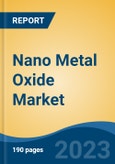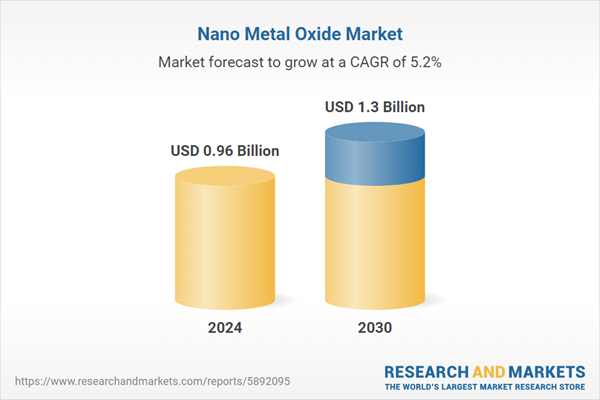Speak directly to the analyst to clarify any post sales queries you may have.
10% Free customizationThis report comes with 10% free customization, enabling you to add data that meets your specific business needs.
This market is not just growing in volume, but also evolving in sophistication. Demand is shifting toward application-specific and surface-functionalized variants that meet stringent performance criteria across regulated sectors like pharmaceuticals and electronics. Moreover, end users are prioritizing consistency, particle size control, and dispersion quality, driving suppliers to invest in precision manufacturing technologies and advanced formulation capabilities.
The market is positioned for long-term value creation, propelled by cross-sectoral innovation, particularly in solid-state batteries, targeted drug delivery systems, smart coatings, and transparent electronics. Strategic collaborations between material scientists, nanotechnology firms, and end-user industries are becoming essential to accelerate commercialization timelines and tailor nanomaterials for emerging needs.
Key Market Drivers
Rising Demand of Nano Metal Oxide in Electronics & Optic Sector
The rising demand for nano metal oxides in the electronics and optics sector is a significant driver propelling the growth of the Global Nano Metal Oxide Market. As electronic devices become increasingly compact, powerful, and multifunctional, the need for materials with exceptional thermal, electrical, and optical properties has become critical making nano metal oxides an essential component in next-generation electronic and photonic systems. Modern electronics demand materials that can function effectively at micro and nano scales without compromising performance.Nano metal oxides such as zinc oxide (ZnO), titanium dioxide (TiO₂), and indium tin oxide (ITO) offer enhanced electrical conductivity, dielectric strength, and thermal stability, making them highly suitable for semiconductors, sensors, thin-film transistors, and integrated circuits. As device sizes shrink, these nanoparticles provide the high surface area and tunable properties needed for advanced component manufacturing. Nano metal oxides are playing a vital role in LCDs, OLEDs, touchscreens, and photodetectors due to their superior optical transparency and conductivity. For instance, indium tin oxide nanoparticles are widely used in transparent conductive coatings, essential for high-resolution displays and solar panels. Similarly, TiO₂ and ZnO nanoparticles are integral to light management layers, anti-reflective coatings, and photocatalytic films in both consumer electronics and industrial optical devices.
The market is witnessing a shift toward flexible, wearable, and printable electronics, where nano metal oxides are proving indispensable. Their ability to be incorporated into inks and coatings enables the development of bendable circuits, smart packaging, and low-cost printed sensors. Solution-processable nano oxides like ZnO and Al₂O₃ are crucial for low-temperature, printable electronic devices, opening new avenues in IoT, healthcare monitoring, and smart textiles.
In a global push toward energy-efficient electronics, nano metal oxides are being utilized to improve power management, heat dissipation, and battery performance. Aluminum oxide (Al₂O₃) and cerium oxide (CeO₂) are often used in insulating layers and dielectric materials to enhance energy storage and minimize leakage current in capacitors and transistors. Their stability at elevated temperatures makes them highly suitable for harsh-environment electronic applications.
Key Market Challenges
Safety and Toxicity Concerns and Environmental Impact
One of the foremost challenges in the nano metal oxide market is ensuring the safety of these materials. The unique properties exhibited at the nanoscale can result in altered reactivity and potential toxicity. Understanding the behavior of nano metal oxides in biological and environmental contexts is crucial. Robust toxicological studies and risk assessments are necessary to ensure the safe utilization of these materials in various applications. Regulatory bodies worldwide are increasingly demanding comprehensive safety evaluations before allowing nano metal oxides to enter the market.Moreover, as the demand for nano metal oxides increases, so does the concern about their environmental impact. The potential release of nano metal oxides into the environment during production, use, and disposal stages raises questions about their persistence and potential to accumulate in ecosystems. Researchers and industries are actively exploring strategies to mitigate these impacts, including developing eco-friendly synthesis methods and improving recycling and waste management techniques.
Key Market Trends
Nanotechnology's Rapid Advancements
The convergence of nanotechnology with various scientific disciplines has propelled the development of novel nano metal oxides. Researchers are leveraging advanced techniques to engineer metal oxides at the nanoscale, allowing for precise control over their size, shape, and properties. This has led to the creation of tailored materials with enhanced functionalities, spurring the adoption of nano metal oxides in diverse applications. The electronics industry has been a major beneficiary of nano metal oxides. These materials offer improved conductivity, high dielectric constants, and enhanced thermal stability, making them invaluable for semiconductor manufacturing, sensors, and displays. As electronic devices continue to shrink in size and demand higher performance, nano metal oxides have become indispensable components enabling technological advancement.The energy sector is undergoing a transformative shift towards sustainable and efficient solutions. Nano metal oxides have emerged as vital players in this transition. They are being used in energy storage systems, such as lithium-ion batteries and supercapacitors, to enhance energy density and charge-discharge rates. Additionally, nano metal oxides find application in solar cells and catalysis, contributing to the development of cleaner and more efficient energy sources. These factors are anticipated to drive the growth of the global Nano Metal Oxide market during the forecast period.
Key Market Players
- Nanophase Technologies Corporation
- American Elements
- SkySpring Nanomaterials, Inc.
- Nanoshel LLC
- Abc Nanotech Co., Ltd.
- Nanostructured & Amorphous Materials, Inc.
- Hongwu International Group Ltd
- Nissan Chemical Corporation
- NYACOL Nano Technologies, Inc
- EPRUI Biotech Co. Ltd.
Report Scope:
In this report, the Global Nano Metal Oxide Market has been segmented into the following categories, in addition to the industry trends which have also been detailed below:Nano Metal Oxide Market, By Product:
- Aluminum Oxide
- Iron Oxide
- Titanium Dioxide
- Silicon Dioxide
- Zinc Oxide
Nano Metal Oxide Market, By Application:
- Electronics & Optics
- Medical & Personal care
- Paints & Coatings
- Others
Nano Metal Oxide Market, By Region:
- North America
- United States
- Canada
- Mexico
- Europe
- France
- Germany
- United Kingdom
- Italy
- Spain
- Asia-Pacific
- China
- India
- South Korea
- Japan
- Australia
- South America
- Brazil
- Argentina
- Colombia
- Middle East & Africa
- South Africa
- Saudi Arabia
- UAE
Competitive Landscape
Company Profiles: Detailed analysis of the major companies present in the Global Nano Metal Oxide Market.Available Customizations:
With the given market data, the publisher offers customizations according to a company's specific needs. The following customization options are available for the report.Company Information
- Detailed analysis and profiling of additional market players (up to five).
Table of Contents
Companies Mentioned
- Nanophase Technologies Corporation
- American Elements
- SkySpring Nanomaterials, Inc.
- Nanoshel LLC
- Abc Nanotech Co., Ltd.
- Nanostructured & Amorphous Materials, Inc.
- Hongwu International Group Ltd
- Nissan Chemical Corporation
- NYACOL Nano Technologies, Inc
- EPRUI Biotech Co. Ltd.
Table Information
| Report Attribute | Details |
|---|---|
| No. of Pages | 180 |
| Published | August 2025 |
| Forecast Period | 2024 - 2030 |
| Estimated Market Value ( USD | $ 0.96 Billion |
| Forecasted Market Value ( USD | $ 1.3 Billion |
| Compound Annual Growth Rate | 5.1% |
| Regions Covered | Global |
| No. of Companies Mentioned | 10 |









